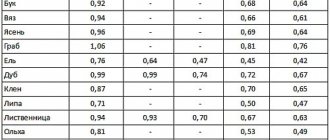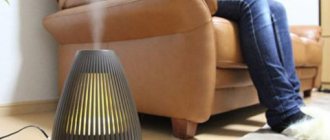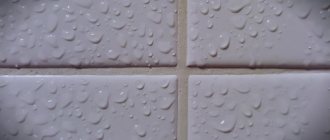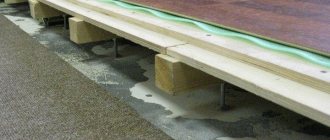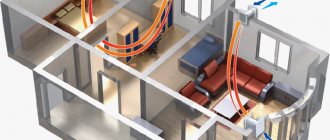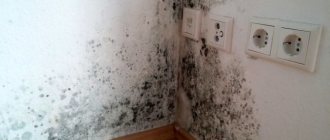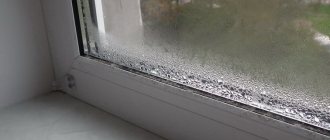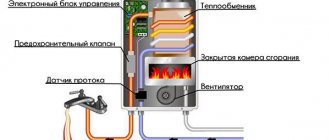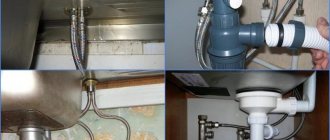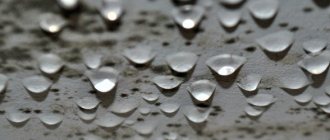The microclimate in an apartment has a significant impact on the health and well-being of its inhabitants. Weakness, loss of performance, increased susceptibility to viral and colds, skin diseases, allergies - this is what dampness in an apartment can threaten. In addition, high humidity causes wooden and leather products and books to deteriorate, and finishing quickly becomes unusable, so to maintain health and home comfort, it is absolutely necessary to combat dampness.
How do you know if the humidity in an apartment is above normal?
You can recognize high humidity in a room by the following signs:
- Fogging of glass surfaces (windows, glass doors, mirrors).
- Wet spots on the walls of the apartment, fungus, mold.
- Wet towels, bed linen, clothes in closets.
- The smell of dampness and mustiness.
Taking a shower
Open windows while showering. Of course, this should not be done in wet weather to avoid getting sick, but be sure to open them in the summer.
The steam will immediately exit the window, condensation will not have time to form and the humidity will not increase.
It’s worth remembering that the longer you shower, the more steam you produce.
If it is not possible to open a window or door, place a fan nearby, or open them after taking a bath.
In summer you can also take a cold shower. This will be useful not only for your home, but also for your health.
Availability of sources of additional moisture
They can serve as:
- Leaking plumbing or pipes. The solution is to check, repair or replace everything you can.
- Flowers. Tropical plants that require frequent watering should be removed from the apartment, giving preference to unpretentious species that will not evaporate a lot of moisture.
- Aquariums in the apartment. If the humidity problem is serious, you will have to give up this hobby and remove the aquarium.
- Large amount of water on the lower floor. This could be a basement, a swimming pool, etc. It’s difficult to do anything here; appeals to the housing office with a request to improve the microclimate of the basement are ineffective, and you can’t get rid of the pool, all that remains is to change your place of residence or install a powerful dehumidifier in the apartment.
- Unscrupulous upstairs neighbors who periodically flood your apartment or have leaking taps. The last factor makes your pipes “sweat” and “cry”. The resulting condensation increases the humidity in the apartment. You can get rid of the problem by calling a mechanic from the housing and communal services; in extreme cases, you can resort to using polyurethane casings by wrapping them around a wet pipe.
USEFUL INFORMATION: How to choose an air humidifier for an apartment: battery-powered humidifiers
Heating radiators
We get rid of excessive amounts of water vapor in the air using conventional batteries. Everyone who lives in cold weather conditions probably has heating appliances.
How to reduce humidity? Everything is very simple. Turn on the gas boiler or light a fire in the stove. Let them do some work. An increase in air temperature will lead to a decrease in moisture.
Heat treatment will not only solve this problem, it will kill the fungus. Try to avoid condensation; if it appears, open the windows and ventilate the room.
Humidity due to improper insulation
If all previous reasons are excluded and you are firmly convinced that the increased humidity in the apartment is due to poor-quality insulation, then legislation and engineering reports with thermal calculations of the walls of the room will help you to determine the required thickness and material of the insulation. Depending on the situation, you may need:
- sealing joints between slabs;
- internal insulation of the apartment;
- insulation of the wall outside the building.
You can find out where moisture is coming into the apartment from using a piece of glass. Place it against the wall for a few minutes. If the side that was pressed against the wall becomes damp, dampness enters the apartment from the street due to defects in the building's design.
Insufficient heating
If you have an apartment with individual heating, then the problem of high humidity is easily solved. In winter, you can regulate the heat supply yourself, reducing or increasing it as needed, but without sudden changes that will aggravate the situation. In damp and humid weather, you need to turn on the heating to dry.
What to do if, with centralized heating, the apartment is not warm enough and because of this the humidity rises?
- Cold pipes may be the result of a lack of heat supply by boiler houses or the initiative of neighbors who decided to remove the bypasses. The solution is to contact utility services.
- Installed decorative grilles on radiators reduce heat transfer by a quarter. It's better to give them up completely.
- Paint on batteries can also reduce heat transfer by 10%; to avoid this, it is necessary to remove the previous layer before painting.
Why is it worth drying out too humid air?
High humidity leads to the appearance of fungus in the house. Its spores are carried through the air, penetrating the lungs of the inhabitants and guests of the house. This causes rhinitis and asthma. If you live permanently in such unfavorable conditions, you are likely to suffer from chronic rhinitis, migraines, and disturbances in the functioning of the cardiovascular system. But there is no need to panic, in most cases you can successfully reduce the humidity.
Ventilation
Ventilation in the apartment is mainly ensured by the presence of ventilation shafts. Ventilation openings and ventilation ducts leading to common shafts are located in places with high humidity: in the bathroom and kitchen. If you have checked the ventilation and found that the draft is weak or absent, one of the following reasons occurs:
- The channel may be clogged with debris. You can get rid of the blockage by cleaning it.
- One of the neighbors, when remodeling or improperly installing the hood in the kitchen, blocked the exhaust shaft. Solving the problem can take a lot of time and effort, if the neighbors do not make contact, there is no need to fight with them, it is better to immediately contact the utility companies first, and then go to court.
USEFUL INFORMATION: Waterproofing a bathroom under tiles: which is better?
There are several more ways to solve the problem of high humidity in an apartment due to poor ventilation:
- Installation of a forced ventilation system. Its disadvantages include some financial costs associated with the purchase of a fan and increased energy consumption, as well as noise. Plus - solving the problem once and for all.
- Installation of a recuperator - a special device that extracts humid air and provides an influx of fresh air. It’s not a cheap thing, but it’s guaranteed to reduce the humidity in the apartment.
Remedies
There are several ways to quickly remove high humidity. You need to take into account the specifics of the room, its area and the ability to implement one or another method of air drying.
Ventilation
Ventilation does not remove the smell of dampness and neutralize high humidity in all cases. This method will help if the weather outside is dry.
It will also be useful:
- Ventilate the bathroom after bathing and heavy laundry.
- Organize good air exchange in the room in which food is prepared.
- Ventilate the room after wet cleaning and other work using large amounts of water.
Heating
Warming up the room during the cold season, when the air temperature inside the building increases significantly, also helps to reduce humidity levels. The result can be achieved by installing additional heating devices - heaters.
When using heaters, there is a danger of drying out the room , and then you will have to deal with another problem - increased dryness. Therefore, it is important to maintain a middle ground.
Special tablets
One solution to the problem of increased dampness is to purchase special tablets that contain absorbent components. They are used with desiccants - containers for collecting the solution that is formed from absorbed moisture.
The productivity of the tablets is up to 400 ml of water per month in a room of up to 20 m². On average, such a tablet should be enough for 2 or 3 months of use.
Products from such well-known manufacturers have good reviews:
- "Stop humidity" from Henkel;
- “Stop moisture” from Ceresit and others.
Folk remedies
Absorbents, which can be used as improvised means, will help dry humid air:
- sugar;
- coffee beans;
- salt;
- rice.
These products have the ability to absorb increased moisture. To normalize humidity, these products can be placed in containers - several per room.
In addition to removing moisture from the air, the products listed can remove unpleasant odors .
For non-residential utility premises, the following containers placed in containers will help remove excess moisture from the air: quicklime, coal, calcium chloride. This method is suitable for damp basements, garages, workshops, etc.
Dehumidifiers
Special devices are used to force dry the air in the room. They allow you to achieve results even in cases where other methods of combating moisture have not helped.
Operating principle of the devices:
- Air absorption through the evaporator.
- Liquid conditioning occurs in the device due to temperature differences. The water flows into a separate container.
- The flow of dried air is returned back into the room.
The advantages of dehumidifiers are the ability to dry even very humid air in a short time.
There are two types of devices:
- Stationary.
- Portable.
The choice depends on the intended use of the device and whether it will need to be moved. It should be borne in mind that stationary models are more powerful, larger, and are not intended to be moved from place to place. For apartments, preference is most often given to dehumidifiers that can be moved from place to place.
The power of the dehumidifier is a very important parameter that must be taken into account when purchasing a device.
NeoClima ND-10AH
Floor installation is designed for rooms with an area of 16 m² . The weight of the device is 11.5 kg. The productivity of the device is 10 liters per day. The model has a filtration system to remove dust particles and wheels to move the device.
The NeoClima dehumidifier is equipped with a timer and display, which makes operation easier. Operating modes – 2, power – 0.23 kW. The volume of the container for collecting condensate is 1.5 l.
Additional functions:
- when the container is filled with condensate - automatic shutdown;
- automatic defrosting.
Price – up to 12,000 rubles. Read reviews here, here and here.
Electrolux EDH-12L
The device is designed for floor or tabletop use in a small room with an area of 15 m², and has a carrying handle. The power declared by the manufacturer is 0.245 kW . The weight of the device itself is 10 kg.
Electrolux has 4 operating modes, productivity – 12 liters per day. The volume of the condensate container is 2.2 liters. The device is completely ready for use and does not require additional installation. The model has indicators and a display.
Additional functions:
- ability to set shutdown time;
- the presence of a clothes drying mode.
The cost is on average about 13,000 rubles, at some points of sale – up to 17,000 rubles. Read reviews here.
Ballu BDM-30L
The Ballu dehumidifier is a floor-standing unit that has electronic controls for quickly setting settings, a built-in timer, indicators and display. The device allows you to dehumidify the air in a room of 50 m². Capacity – 30 liters per day .
The volume of the condensate container is 5 liters. Maximum power – 0.54 kW. The weight of the entire device is 14.6 kg.
Additional functions:
- Air ionization.
- Automatic shutdown when the container is full of condensate.
- Possibility to adjust fan speed.
- Set off and on times.
- Clothes drying mode.
Cost – about 22,500 rubles. Read reviews here and here.
General recommendations
In addition to individual methods for eliminating humidity in an apartment, specific to each individual case, there are also general ones.
- Regular ventilation of the room. It has long been known that humidity is afraid of fresh air.
- Buying a dehumidifier. The more powerful the equipment, the greater the effect of its work, the faster you will be able to get rid of high humidity.
The best option is a dehumidifier with a humidity sensor that responds to the percentage of moisture in the room air. Automatic mode will help avoid over-drying and save energy.
Renovating apartments with high humidity has its own characteristics. Necessary:
- Use natural materials that do not create a greenhouse effect and regulate the level of humidity in the room, and avoid vinyl wallpaper, PVC panels and other vapor-proof materials.
- Do waterproofing.
- Add antifungal components to the mixtures used and treat against mold.
The effect of dampness on housing and people
In case of untimely actions aimed at eliminating dampness, or in case of ignoring the problem, unpleasant consequences will certainly arise.
- A persistent heavy smell characteristic of basements will appear in the apartment
- Finishing materials, namely wallpaper or plaster, will begin to peel off. The putty saturated with moisture becomes loose and moves away from the surface of the wall or ceiling in whole layers;
- Wooden floors or floor coverings may become deformed, cracks will form at the joints of elements, and a characteristic creaking will appear;
- Furniture items made from natural materials will also be subject to deformation;
- In the case when the humidity level exceeds normal levels for humans of 40-60%, this leads to aggravation respiratory diseases or their development;
- Allergies may worsen;
- All microbes and bacteria develop much faster and more actively in a humid environment;
- Skin rashes will appear, wounds or scratches will take longer to heal or rot;
- Such a microclimate is especially dangerous for young children, whose immunity has not yet strengthened and cannot provide adequate resistance. Children are easily susceptible to illness and stay sick longer;
- A clear consequence will be education on the walls or ceiling of black fungus, that is mold.
